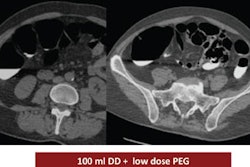A British study confirms the high sensitivity and specificity of PET/CT in identifying focal bony disease in patients with Hodgkin's disease, according to research presented at the recent 2008 RSNA meeting. The results further suggest that the imaging modality can play an important role in initial staging of the disease.
Based on their findings, researchers from Royal Marsden Hospital in London are recommending that FDG-PET/CT be utilized for all Hodgkin's lymphoma patients to stage their cancer. They also are advising that bone marrow trephine biopsy be use "far more judiciously."
Traditionally, bone marrow trephine biopsy has been the investigation of choice to rule out bone marrow involvement.
"Bone marrow involvement in Hodgkin's lymphoma is important, because it changes in terms of staging and subsequently can change the treatment in many cases," noted Dr. Axel Martin, co-author of the study and a radiologist at Royal Marsden Hospital. "We now recommend FDG-PET/CT as a staging tool of choice, compared to bone marrow results."
Study objectives
The purpose of the study was to assess the conventional staging of patients with Hodgkin's disease with multidetector CT, histology from the primary tumor, and bone marrow biopsy. Researchers also sought to determine if FDG-PET/CT correlated with the results of anatomical imaging and bone marrow biopsy.
The retrospective research analyzed 40 random, consecutive Hodgkin's disease patients at Royal Marsden Hospital, who underwent bone marrow biopsy, multidetector CT, and PET/CT in the initial staging of their disease. There were 24 male and 16 female patients, with a median age at diagnosis of 26 years, ranging from 11 to 71 years.
The researchers concluded that seven patients (18%) with Hodgkin's disease had bone involvement. They also found discord between imaging findings and bone marrow biopsy results in five patients (13%).
"We found seven of our patients were FDG-avid for bone foci on PET and five lesions we could see on CT," said Martin. "In only two of the seven [patients] did we find involvement with bone marrow histology."
Both of those patients also had abnormal focal skeletal tracer accumulation on PET/CT and suspicious findings on multidetector CT.
Patient results
Of the seven patients, five patients (13%) demonstrated abnormal focal bone involvement on PET/CT without histological evidence of bone marrow disease. Three of those five patients had corresponding bone changes on multidetector CT.
In the study, researchers also noted that "no factors predicting the presence of focal bony disease could be identified. In contrast to other studies, no cases with histological bone marrow involvement, but negative PET/CT, were found."
Given the results, the researchers confirmed the use of FDG-PET as a primary staging tool in Hodgkin's disease, and highlighted the existence of focal bony metastases on other imaging and bone marrow histology.
"PET/CT should be performed for all patients with Hodgkin's lymphoma," Martin said. "At this point, we think that bone marrow trephine should be targeted in the future, and used far more judiciously."
By Wayne Forrest
AuntMinnie.com staff writer
December 19, 2008
Related Reading
Female Hodgkin's survivors have greater risk of secondary cancer, October 28, 2008
Late effects of Hodgkin's lymphoma salvage therapy 'significant,' October 20, 2008
FDG-PET/CT trumps bone scintigraphy for young Hodgkin's lymphoma patients, June 30, 2008
Salvage radiotherapy effective in relapsed or refractory Hodgkin's disease, April 5, 2005
Study: Kids face more problems after beating cancer, July 15, 2004
Copyright © 2008 AuntMinnie.com


















